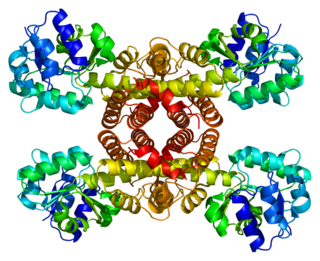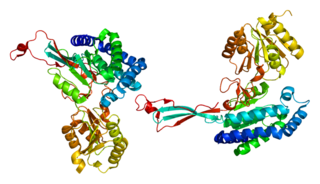
Mitochondrial 5-demethoxyubiquinone hydroxylase, also known as coenzyme Q7, hydroxylase, is an enzyme that in humans is encoded by the COQ7 gene. The clk-1 (clock-1) gene encodes this protein that is necessary for ubiquinone biosynthesis in the worm Caenorhabditis elegans and other eukaryotes. The mouse version of the gene is called mclk-1 and the human, fruit fly and yeast homolog COQ7.

1-Pyrroline-5-carboxylic acid is a cyclic imino acid. Its conjugate base and anion is 1-pyrroline-5-carboxylate (P5C). In solution, P5C is in spontaneous equilibrium with glutamate-5-semialdhyde (GSA).

Hyperprolinemia is a condition which occurs when the amino acid proline is not broken down properly by the enzymes proline oxidase or pyrroline-5-carboxylate dehydrogenase, causing a buildup of proline in the body.

In enzymology, a 3-hydroxyisobutyrate dehydrogenase also known as β-hydroxyisobutyrate dehydrogenase or 3-hydroxyisobutyrate dehydrogenase, mitochondrial (HIBADH) is an enzyme that in humans is encoded by the HIBADH gene.
In enzymology, a 1-pyrroline-5-carboxylate dehydrogenase (EC 1.2.1.88) is an enzyme that catalyzes the chemical reaction

In enzymology, proline dehydrogenase (PRODH) (EC 1.5.5.2, formerly EC 1.5.99.8) is an enzyme of the oxidoreductase family, active in the oxidation of L-proline to (S)-1-pyrroline-5-carboxylate during proline catabolism. The end product of this reaction is then further oxidized in a (S)-1-pyrroline-5-carboxylate dehydrogenase (P5CDH)-dependent reaction of the proline metabolism, or spent to produce ornithine, a crucial metabolite of ornithine and arginine metabolism. The systematic name of this enzyme class is L-proline:quinone oxidoreductase. Other names in common use include L-proline dehydrogenase, L-proline oxidase,and L-proline:(acceptor) oxidoreductase. It employs one cofactor, FAD, which requires riboflavin (vitamin B2).

In enzymology, a pyrroline-5-carboxylate reductase (EC 1.5.1.2) is an enzyme that catalyzes the chemical reaction

Sterol-4-alpha-carboxylate 3-dehydrogenase, decarboxylating is an enzyme that in humans is encoded by the NSDHL gene. This enzyme is localized in the endoplasmic reticulum and is involved in cholesterol biosynthesis.

D-2-hydroxyglutarate dehydrogenase, mitochondrial is an enzyme that in humans is encoded by the D2HGDH gene.

NADH dehydrogenase [ubiquinone] flavoprotein 3, mitochondrial is an enzyme that in humans is encoded by the NDUFV3 gene.

Pyrroline-5-carboxylate reductase 1, mitochondrial is an enzyme that in humans is encoded by the PYCR1 gene.

Prolyl 4-hydroxylase subunit alpha-2 is an enzyme that in humans is encoded by the P4HA2 gene.

Delta-1-pyrroline-5-carboxylate synthetase (P5CS) is an enzyme that in humans is encoded by the ALDH18A1 gene. This gene is a member of the aldehyde dehydrogenase family and encodes a bifunctional ATP- and NADPH-dependent mitochondrial enzyme with both gamma-glutamyl kinase and gamma-glutamyl phosphate reductase activities. The encoded protein catalyzes the reduction of glutamate to delta1-pyrroline-5-carboxylate, a critical step in the de novo biosynthesis of proline, ornithine and arginine. Mutations in this gene lead to hyperammonemia, hypoornithinemia, hypocitrullinemia, hypoargininemia and hypoprolinemia and may be associated with neurodegeneration, cataracts and connective tissue diseases. Alternatively spliced transcript variants, encoding different isoforms, have been described for this gene. As reported by Bruno Reversade and colleagues, ALDH18A1 deficiency or dominant-negative mutations in P5CS in humans causes a progeroid disease known as De Barsy Syndrome.

Delta(3,5)-Delta(2,4)-dienoyl-CoA isomerase, mitochondrial is an enzyme that in humans is encoded by the ECH1 gene.

39S ribosomal protein L37, mitochondrial is a protein that in humans is encoded by the MRPL37 gene.

39S ribosomal protein L17, mitochondrial is a protein that in humans is encoded by the MRPL17 gene.

28S ribosomal protein S25, mitochondrial is a protein that in humans is encoded by the MRPS25 gene.

Aldehyde dehydrogenase 1 family, member L2 also known as ALDH1L2 is an enzyme that in humans is encoded by the ALDH1L2 gene. ALDH1L2 is the mitochondrial isoform of a similar enzyme, ALDH1L1, which converts 10-formyltetrahydrofolate to tetrahydrofolate and carbon dioxide.

Pyrroline-5-carboxylate reductase family, member 2 is a protein that in humans is encoded by the PYCR2 gene.

NADP-dependent oxidoreductase domain-containing protein 1 is a protein that in humans is encoded by the NOXRED1 gene. An alias of this gene is Chromosome 14 Open Reading Frame 148 (c14orf148). This gene is located on chromosome 14, at 14q24.3. NOXRED1 is predicted to be involved in pyrroline-5-carboxylate reductase activity as part of the L-proline biosynthetic pathway. It is expressed in a wide variety of tissues at a relatively low level, including the testes, thyroid, skin, small intestine, brain, kidney, colon, and more.























